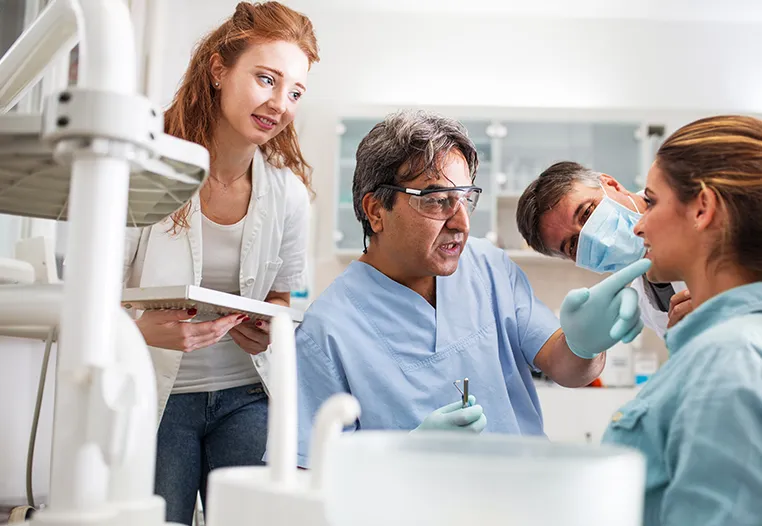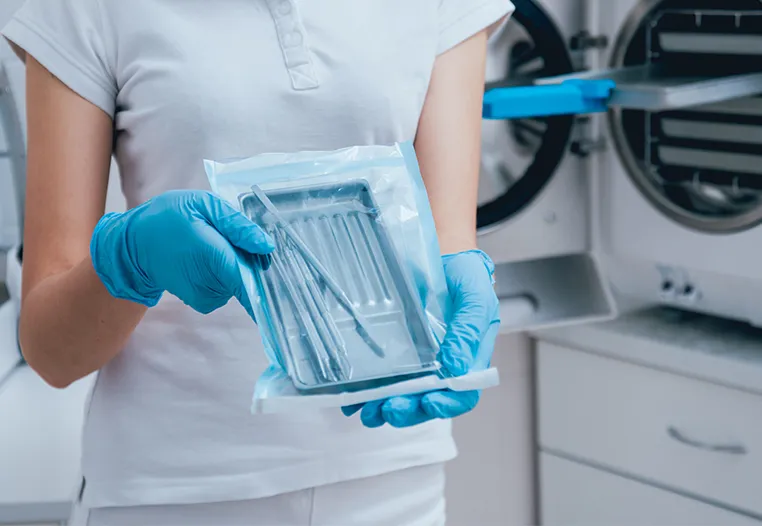Knowledge and Training
The first step toward change is awareness. Awareness and knowledge are among the essential requirements for control and prevention of infection in dentistry. All parties involved in dental treatment must be aware of the possible processes of the spread of dental disease from one patient to another. Three parties are involved:
- The patient - dental professionals must educate the patients about infection control, and how they can play their part in preventing the spread of infection from one patient to another.
- Dental Professionals - overall, dentists are responsible for educating and training their team members regarding the importance of cross-infection control. They must also ensure the professional development of the newcomers in their practice.
- Dental Healthcare Professionals - healthcare professionals, must also keep their knowledge up to date, through all available sources, to pass profession development courses, and to educate the patients and staff.
Ethical Commitment
Education and awareness alone are not enough. A professional must possess an ethical and professional commitment to ensure the control of dental infection and disease. Education and mindfulness, will, of course, help develop this commitment.

Adherence to Standards and Guidelines
The responsibility for providing standards and guidelines for safe practice are overseen on the national and international level. In the UK, for example, the Infection prevention society provides guidelines which should be followed by dental professionals for practicing control and prevention of cross-infection in the dental environment. . Dental professionals should understand the requirements in their county as well as international standards. Generally, there are two levels of preventative measures.
Standard
Taken with all patients as a routine without any knowledge of the patient’s infection status. These must be taken to minimize the risk of infection transmission from the secretions, excretions, body fluids, blood, etc., from the patient. They include:
- Washing Hands – this is probably the most crucial protective measure against cross-infection in dental settings. The world health Organization (WHO) recommends that all healthcare professionals should wash their hands before seeing any patients. Besides, dental professionals must wash their hands before and immediately after performing any surgical procedure. For routine examinations, washing hands with soap or an alcohol-based detergent can be used. However, for surgical procedures, thorough hand scrubbing along with cleansing under the nails should be performed.
- Protective clothing and articles – personal protective equipment (PPE) including gloves, masks, and goggles are effective in preventing disease transmission in dental the settings. Gloves form an adequate barrier and prevent the passage of bacteria from patients’ blood and body fluids. Similarly, masks and eye goggles are highly effective against preventing the transmission of airborne infections. Additionally, it is recommended that oral healthcare professionals wear long sleeves when using gowns as protective barriers.
- Proper management of waste produced during the dental clinical procedure must be ensured so that they do not become a source of infection for the patients and the healthcare providers.
- Handling and disposal of needles and sharps – virtually all dental procedures require the use of sharp surgical instruments, that can act as a source of cross-infection, if not disposed of properly. Dental practices should have defined processes to secure the working ends of disposable instruments before discarding them. On the other hand, sharp instruments that are reusable must be adequately sterilized before reusing on the next patient.
- Cleaning, decontamination, and sterilization – sterilization ensures that all the micro-organisms, including spores on a surface of dental instruments, are destroyed, thereby reducing the chances of cross-infection. An advanced end to end solution that covers the decontamination and sterilization process from start to end will keep you covered and provide the peace of mind needed to focus on treating your patients. Make sure your solution provider can answer every step of the process with the following: an Ultrasonic Cleaner to rid of hard disposals, a Sealing Machine to ensure adequate sterile storage until instruments are reused, a high-quality washer-disinfector to disinfect the instruments before they enter the sterilizer and most importantly an advanced autoclave that will provide high-quality results with zero compromise. Having high-end equipment can make the entire process hassle-free and increase the productivity of your staff, leaving more time to focus on patient care.
Special Precautions for At-Risk Patients
Precautions must be practiced with patients suffering from infectious diseases such as HIV, Hepatitis B and C:
- Air Born Infection – protection against airborne infections demands immunization against flu, active tuberculosis, or varicella. This could also involve usage of immunized respiratory masks, preferably in rooms with negative pressure.
- Contact Precautions – Usage of plastic aprons and gloves during operations is recommended. They must be used, for example, against MRSA, shingles, or Impetigo.

Cleaning the Dental Unit Waterline
Another potential source of infection in dental practice is the waterline. A dedicated waterline should be arranged for sterilization, and for instruments that require water during use, such as dental handpieces, ultrasonic scalers etc. Regular inspection of the waterline is also necessary to prevent biofilm formation that can result in infection.
Patient History Tracking
Another potential source of infection in dental practice is the waterline. A dedicated waterline should be arranged for sterilization, and for instruments that require water during use, such as dental handpieces, ultrasonic scalers etc. Regular inspection of the waterline is also necessary to prevent biofilm formation that can result in infection.
Let's Summarize
The purpose of these measures is to prevent and control infection, and they must become an essential part of any dental practice’s core values. Dentists and clinic managers are entrusted with the safety of their patients and dental team. Therefore, they should devise a comprehensive process within their practice to minimize infection transmission, and to create a safe atmosphere for their patients and dental staff. If your practice follows infection control guidelines combined with the use of high quality sterile processing products and solutions, then you are most likely to be ranked among the top in the field. It’s clear that a dental professional who emphasizes safety, not only because it’s required, but as something of values is worthy to be trusted and respected by patients.
About Tuttnauer – You’re a one-stop shop for sterile dental processing
Tuttnauer provides end to end sterile processing solutions for dental clinics, including; advanced autoclave sterilizers, washer-disinfectors, indicators and sterile processing products. The T-Edge 23 autoclaves were explicitly developed for dental practices. They meet all your sterilization needs by creating cyclic parameters that accommodate with the most challenging loads, ensuring sterility and efficient drying, helping dentists achieve today’s challenging workloads and provide superior patient care, without risking cross patient contamination.
For further information and to inquire about purchasing the T-Edge 10 autoclave for your practice, visit the T-Edge page on our website.